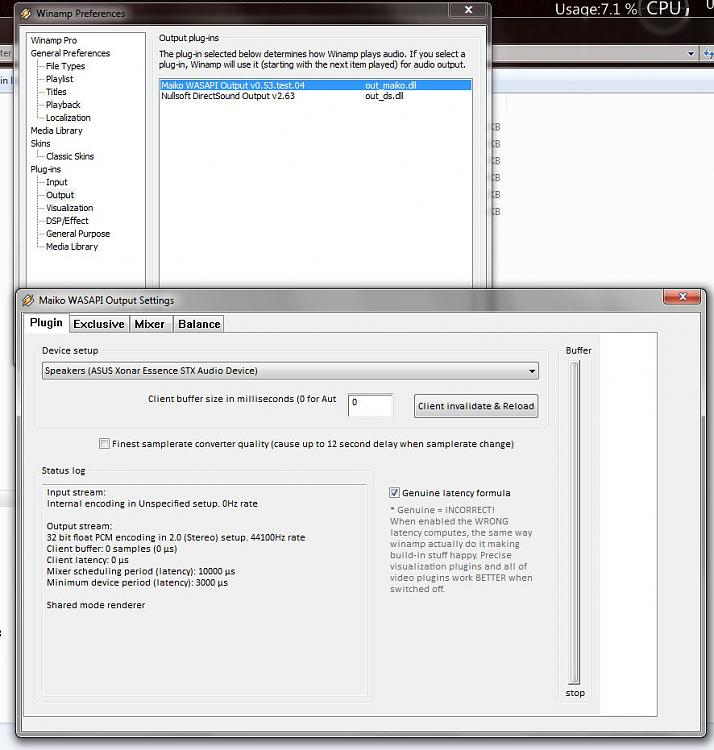WASAPI - this is a lot better than DirectSound as it provides less latency (usually between 10ms and 30ms) so it's more suitable to real-time use. It also provides access to both inputs and outputs and multiple channels (if it's properly configured in Windows). This Maiko WASAPI Plugin App installation file is completely not hosted on our Server. Whenever you click the “Download” link on this web page, files will downloading directly in the owner sources (Official sites/Mirror Website). Maiko WASAPI Plugin is a windows app that created by Evgeny Stets. We are not straight affiliated with them.
Note: this article only applies to Windows (specifically Windows 7 and above)
The general rule of thumb is: if possible try to select in this order: ASIO, WASAPI, DirectSound (default mode).
- DirectSound - this is the standard audio mode on Windows (along with MME but we don't use that in FutureDecks). It always works but it almost always works only in stereo mode and outputs only. What this means is that even if you have a soundcard with multiple inputs and outputs, you will most likely get working only 1 stereo output (without the other outputs and inputs). The latency is extremely big (usually between 50ms and 80ms) so you can't properly scratch or do any true real-time work. Also, you can't use timecodes (since you don't have any inputs and the latency is very bad). Getting separate heaphones/speakers signals is tricky since you almost always only get a single stereo output (maybe you can use split mode -- use left channel for speakers and right channel for headphones). You should use this only if your audio device doesn't support the other modes.
- WASAPI - this is a lot better than DirectSound as it provides less latency (usually between 10ms and 30ms) so it's more suitable to real-time use. It also provides access to both inputs and outputs and multiple channels (if it's properly configured in Windows). There are some problems (like out of sync between outputs and inputs, pops, clicks, stutters, etc) in full-duplex mode (using both outputs and inputs) on some audio devices but in general it works ok. You should use this if your soundcard doesn't have an ASIO device.
- ASIO - use this whenever you can. This is by far the best audio mode possible in Windows. It provides extremely low latencies (usually between 1ms-10ms) so it's perfect for timecodes, scratching and pretty much anything that you want to be real-time. Unfortunately not all audio devices (soundcards) have a driver for this. You need to check the CD that came with the device or look at the manufacturer's website for a specific driver for your device. Alternatively, you can use ASIO4ALL (a software which simulates ASIO for an audio device without one) but you might get mixed results - it might work perfectly or it may not. You should always choose this interface/mode when possible.
So, once more: use ASIO if it's available for your audio device. If not, use WASAPI and only as a last resort use DirectSound.
Here's a couple of alternatives for you:

Maiko Wasapi Output
First of all, you need a standalone VST Host. For instance Bidule from
Plogue.
Maiko Wasapi
The VST host (and the convolver plugin) sits between inputs and outputs on
the sound card. You decide which inputs and ouputs.
Alternative A: If you have at least two (for stereo) extra outputs available
on your sound card (e.g. SPDIF out) you can choose that output for those
sources and loop it back to an available input. This can be done with an
SPDIF cable if you have spdif in and out available. But some cards have
rerouting included in their driver & software so you can do this without
real cables. Then you hook up the VST host and the VST plugin to take the
audio from the SPDIF input, process it and send it to the speakers. You
should use Asio inside the VST environment if you can. And you have to use
windowsMME, direct sound or Wasapi between the other players and the sound
card.
Alternative B: If you don't have extra outputs available try this:
Virtual Audio Cable(VAC). Configure a stereo cable and use this as the
'output channels' for the other sources. Use the Asio wrapper Asio4All, and
configure it so that VAC is the input and your real sound card is the
output. Then choose VAC as sound card in the VST host. Be aware that VAC is
clocked by the operative system and not by the sound card, so there may be
glitches in the Audio. But you can adjust the playback speed in VAC and you
can also use large buffers in the sound card and in the VST host. And that
usually gives you glitch free playback. This rendering path may not be bit
perfect, since the windows mixer will be in the path, so alternative A is
better if you have the hardware capabilities for it.
Maiko Wasapi
Once you've got it working you can save the setup in the VST host so it will
be easy to use the next time.
You will have to shut down JRiver when you use the VST host and you have to
shut down the VST host when you use JRiver. They both run in exclusive mode.
Maiko Wasapi Download
Also, there are a few dynamic link library files (dll's) that sits in the
Convolver folder that you probably have to copy over to the VST program
folder to make ConvolverVST work. Libsnd.dll, ffftw.dll and perhaps one
more.
It can be a bit tweaky to make this work so I hope someone with such a setup
can contribute with their experiences here.
